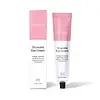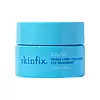What's inside
What's inside
 Key Ingredients
Key Ingredients

 Benefits
Benefits

 Concerns
Concerns

No concerns
 Ingredients Side-by-side
Ingredients Side-by-side

Water
Skin ConditioningCoco-Caprylate
EmollientUrea
BufferingGlyceryl Stearate
EmollientBacillus Ferment
Skin ConditioningCetyl Alcohol
EmollientDalea Spinosa Seed Oil
MaskingTocopherol
AntioxidantPolyglyceryl-6 Stearate
EmollientStearic Acid
CleansingSimmondsia Chinensis Seed Oil
EmollientOryza Sativa Bran Oil
EmollientHexylresorcinol
AntimicrobialGlycerin
HumectantSodium Anisate
AntimicrobialSodium Levulinate
Skin ConditioningSodium Ascorbyl Phosphate
AntioxidantLactic Acid
BufferingGlyceryl Caprylate
EmollientPolyglyceryl-6 Behenate
Emulsion StabilisingGellan Gum
Ferulic Acid
AntimicrobialGlycyrrhiza Glabra Root Extract
BleachingSodium Phytate
Chamomilla Recutita Flower Extract
MaskingXanthan Gum
EmulsifyingCitric Acid
BufferingPotassium Sorbate
PreservativeWater, Coco-Caprylate, Urea, Glyceryl Stearate, Bacillus Ferment, Cetyl Alcohol, Dalea Spinosa Seed Oil, Tocopherol, Polyglyceryl-6 Stearate, Stearic Acid, Simmondsia Chinensis Seed Oil, Oryza Sativa Bran Oil, Hexylresorcinol, Glycerin, Sodium Anisate, Sodium Levulinate, Sodium Ascorbyl Phosphate, Lactic Acid, Glyceryl Caprylate, Polyglyceryl-6 Behenate, Gellan Gum, Ferulic Acid, Glycyrrhiza Glabra Root Extract, Sodium Phytate, Chamomilla Recutita Flower Extract, Xanthan Gum, Citric Acid, Potassium Sorbate
Water
Skin ConditioningCaprylyl Caprylate/Caprate
EmollientJojoba Oil/Macadamia Seed Oil Esters
Skin ConditioningPropanediol
SolventNiacinamide
SmoothingAmmonium Acryloyldimethyltaurate/Vp Copolymer
Hydroxyethyl Acrylate/Sodium Acryloyldimethyl Taurate Copolymer
Emulsion StabilisingCollagen Amino Acids
MoisturisingSqualane
EmollientCaffeine
Skin ConditioningSqualene
EmollientMacadamia Integrifolia Seed Oil
Skin ConditioningAsparagopsis Armata Extract
Skin ProtectingHydrogenated Starch Hydrolysate
HumectantPhytosteryl Macadamiate
Skin ConditioningAcetyl Glucosamine
Skin ConditioningAcetyl Glutamine
Skin ConditioningLecithin
EmollientPhospholipids
Skin ConditioningLeuconostoc/Radish Root Ferment Filtrate
AntimicrobialPolyglutamic Acid
Skin ConditioningPhytosterols
Skin ConditioningAscophyllum Nodosum Extract
Skin ConditioningCeramide NP
Skin ConditioningBacillus/Soybean Ferment Extract
Skin ConditioningOligopeptide-3
Skin ConditioningOligopeptide-2
Skin ConditioningOligopeptide-1
Skin ConditioningHexapeptide-11
Skin ConditioningTocopheryl Acetate
AntioxidantSodium Hyaluronate
HumectantFolic Acid
Skin ConditioningAmylopectin
Tocopherol
AntioxidantPhytosphingosine
Skin ConditioningCeramide AP
Skin ConditioningCholesterol
EmollientLithothamnion Calcareum Extract
Skin ConditioningLactic Acid
BufferingMyrica Cerifera Fruit Extract
HumectantHydroxyacetophenone
AntioxidantPrunus Lannesiana Flower Extract
Skin ConditioningAkebia Quinata Stem Extract
Skin ConditioningSaccharomyces Lysate
Skin ConditioningLactobacillus Ferment Lysate
Skin ConditioningCeramide EOP
Skin ConditioningTripeptide-1
Skin ConditioningCaprylyl Glycol
EmollientPolysorbate 60
EmulsifyingGlycerin
HumectantEthylhexylglycerin
Skin ConditioningHexylene Glycol
EmulsifyingSodium Lauroyl Lactylate
EmulsifyingSorbitan Isostearate
EmulsifyingTrisodium Ethylenediamine Disuccinate
Butylene Glycol
HumectantPentylene Glycol
Skin ConditioningXanthan Gum
EmulsifyingCarbomer
Emulsion StabilisingSodium Benzoate
MaskingPotassium Sorbate
Preservative1,2-Hexanediol
Skin ConditioningDextran
Phenoxyethanol
PreservativeWater, Caprylyl Caprylate/Caprate, Jojoba Oil/Macadamia Seed Oil Esters, Propanediol, Niacinamide, Ammonium Acryloyldimethyltaurate/Vp Copolymer, Hydroxyethyl Acrylate/Sodium Acryloyldimethyl Taurate Copolymer, Collagen Amino Acids, Squalane, Caffeine, Squalene, Macadamia Integrifolia Seed Oil, Asparagopsis Armata Extract, Hydrogenated Starch Hydrolysate, Phytosteryl Macadamiate, Acetyl Glucosamine, Acetyl Glutamine, Lecithin, Phospholipids, Leuconostoc/Radish Root Ferment Filtrate, Polyglutamic Acid, Phytosterols, Ascophyllum Nodosum Extract, Ceramide NP, Bacillus/Soybean Ferment Extract, Oligopeptide-3, Oligopeptide-2, Oligopeptide-1, Hexapeptide-11, Tocopheryl Acetate, Sodium Hyaluronate, Folic Acid, Amylopectin, Tocopherol, Phytosphingosine, Ceramide AP, Cholesterol, Lithothamnion Calcareum Extract, Lactic Acid, Myrica Cerifera Fruit Extract, Hydroxyacetophenone, Prunus Lannesiana Flower Extract, Akebia Quinata Stem Extract, Saccharomyces Lysate, Lactobacillus Ferment Lysate, Ceramide EOP, Tripeptide-1, Caprylyl Glycol, Polysorbate 60, Glycerin, Ethylhexylglycerin, Hexylene Glycol, Sodium Lauroyl Lactylate, Sorbitan Isostearate, Trisodium Ethylenediamine Disuccinate, Butylene Glycol, Pentylene Glycol, Xanthan Gum, Carbomer, Sodium Benzoate, Potassium Sorbate, 1,2-Hexanediol, Dextran, Phenoxyethanol
 Reviews
Reviews

Ingredients Explained
These ingredients are found in both products.
Ingredients higher up in an ingredient list are typically present in a larger amount.
Glycerin is already naturally found in your skin. It helps moisturize and protect your skin.
A study from 2016 found glycerin to be more effective as a humectant than AHAs and hyaluronic acid.
As a humectant, it helps the skin stay hydrated by pulling moisture to your skin. The low molecular weight of glycerin allows it to pull moisture into the deeper layers of your skin.
Hydrated skin improves your skin barrier; Your skin barrier helps protect against irritants and bacteria.
Glycerin has also been found to have antimicrobial and antiviral properties. Due to these properties, glycerin is often used in wound and burn treatments.
In cosmetics, glycerin is usually derived from plants such as soybean or palm. However, it can also be sourced from animals, such as tallow or animal fat.
This ingredient is organic, colorless, odorless, and non-toxic.
Glycerin is the name for this ingredient in American English. British English uses Glycerol/Glycerine.
Learn more about GlycerinLactic Acid is another well-loved alpha hydroxy acid (AHA). It is gentler than glycolic acid but still highly effective.
Its main role is to exfoliate the surface of the skin by loosening the “glue” that holds dead skin cells together. Shedding those old cells leads to smoother, softer, and more even-toned skin.
Because lactic acid molecules are larger than glycolic acid, they don’t penetrate as deeply. This means they’re less likely to sting or irritate, making it a great choice for beginners or those with sensitive skin.
Like glycolic acid, it can:
Lactic acid also acts as a humectant (like hyaluronic acid). It can draw water into the skin to improve hydration and also plays a role in the skin's natural moisturizing factor (NMF) in the form of sodium lactate.
Studies show it can boost ceramide production to strengthen the skin barrier and even help balance the skin’s microbiome.
To get results, choose products with a pH between 3-4.
Lower strengths (5-12%) focus on surface exfoliation; higher strengths (12% and up) can reach deeper in the dermis (deeper, supportive layer) to improve skin texture and firmness over time.
Though it was originally derived from milk, most modern lactic acid used in skincare is vegan. It is made through non-dairy fermentation to create a bio-identical and stable form suitable for all formulations.
When lactic acid shows up near the end of an ingredient list, it usually means the brand added just a tiny amount to adjust the product’s pH.
Legend has it that Cleopatra used to bathe in sour milk to help reduce wrinkles.
Lactic acid is truly a gentle multitasker: it exfoliates, hydrates, strengthens, and brightens. It's a great ingredient for giving your skin a smooth, glowing, and healthy look without the harshness of stronger acids.
Read more about some other popular AHA's here:
Learn more about Lactic AcidPotassium Sorbate is a preservative used to prevent yeast and mold in products. It is commonly found in both cosmetic and food products.
This ingredient comes from potassium salt derived from sorbic acid. Sorbic acid is a natural antibiotic and effective against fungus.
Both potassium sorbate and sorbic acid can be found in baked goods, cheeses, dried meats, dried fruit, ice cream, pickles, wine, yogurt, and more.
You'll often find this ingredient used with other preservatives.
Learn more about Potassium SorbateTocopherol (also known as Vitamin E) is a common antioxidant used to help protect the skin from free-radicals and strengthen the skin barrier. It's also fat soluble - this means our skin is great at absorbing it.
Vitamin E also helps keep your natural skin lipids healthy. Your lipid skin barrier naturally consists of lipids, ceramides, and fatty acids. Vitamin E offers extra protection for your skin’s lipid barrier, keeping your skin healthy and nourished.
Another benefit is a bit of UV protection. Vitamin E helps reduce the damage caused by UVB rays. (It should not replace your sunscreen). Combining it with Vitamin C can decrease sunburned cells and hyperpigmentation after UV exposure.
You might have noticed Vitamin E + C often paired together. This is because it is great at stabilizing Vitamin C. Using the two together helps increase the effectiveness of both ingredients.
There are often claims that Vitamin E can reduce/prevent scarring, but these claims haven't been confirmed by scientific research.
Learn more about TocopherolWater. It's the most common cosmetic ingredient of all. You'll usually see it at the top of ingredient lists, meaning that it makes up the largest part of the product.
So why is it so popular? Water most often acts as a solvent - this means that it helps dissolve other ingredients into the formulation.
You'll also recognize water as that liquid we all need to stay alive. If you see this, drink a glass of water. Stay hydrated!
Learn more about WaterXanthan gum is used as a stabilizer and thickener within cosmetic products. It helps give products a sticky, thick feeling - preventing them from being too runny.
On the technical side of things, xanthan gum is a polysaccharide - a combination consisting of multiple sugar molecules bonded together.
Xanthan gum is a pretty common and great ingredient. It is a natural, non-toxic, non-irritating ingredient that is also commonly used in food products.
Learn more about Xanthan Gum